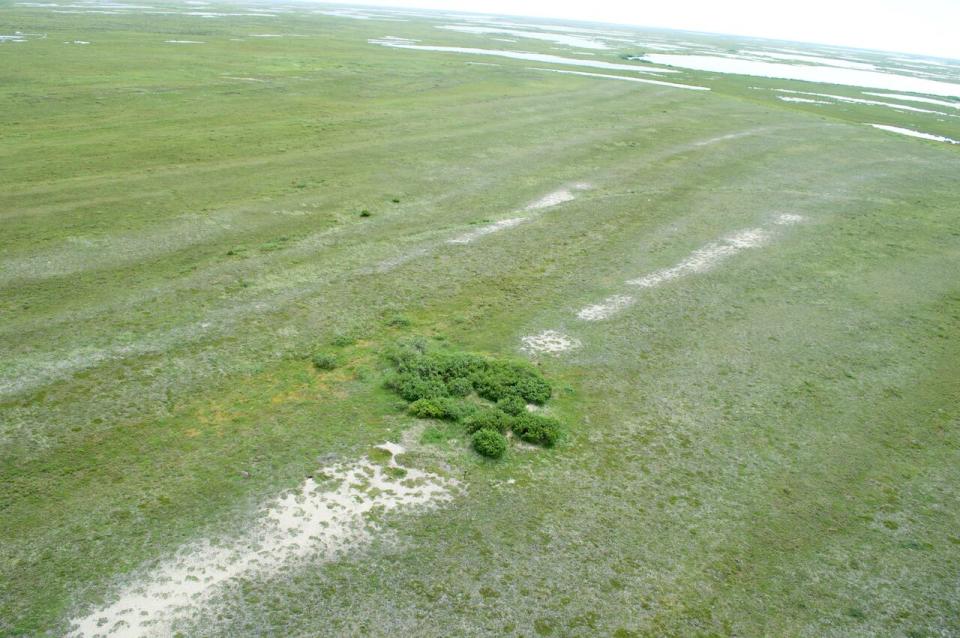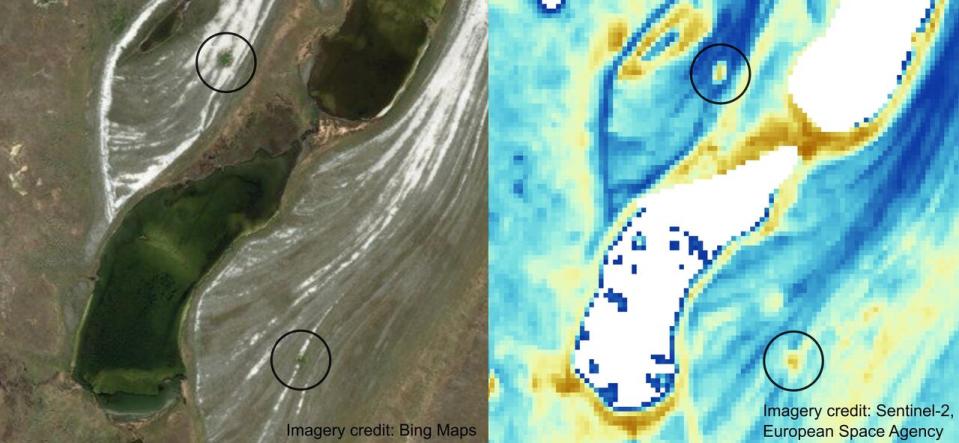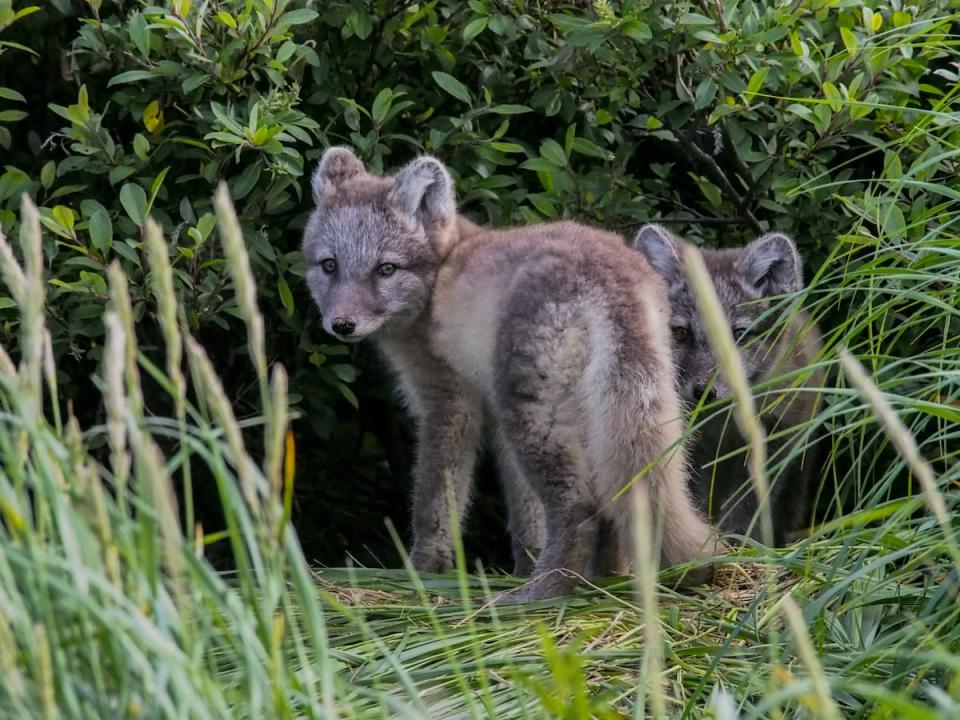Spying on Arctic foxes from space reveals the species have a green thumb effect on tundra

The effects of climate change appear to be driving Arctic fox numbers down in northern Manitoba, threatening their role as "ecosystem engineers" that have a green thumb effect on relatively barren swaths of tundra.
That's according to two separate studies published this summer based on recent research in the Churchill area.
"We have classified Arctic foxes as the sort of unique keystone ecosystem engineers in tundra ecosystems because they benefit other plants in the area through their denning activity," said Sean Johnson-Bice, a PhD candidate at the University of Manitoba (U of M).
"These dens are also really important sites likely for other species as well."
In one study, Johnson-Bice and his colleagues spied on Arctic fox dens — from space.
Satellite imagery
Churchill, about 1,000 kilometres north of Winnipeg, and the neighbouring Wapusk region to the southeast represent the southernmost range of Arctic fox habitat. It's at these edges where the seasonally snow-white polar predators occasionally decide to dig out dens in otherwise nutrient poor ridges on tundra without much vegetation.
Through analyzing high-resolution satellite imagery, the team found they could pick out dens from above.

An aerial shot of an Arctic fox den on the tundra near Churchill, about 1,000 kilometres north of Winnipeg, shows a comparatively lush clump of vegetation growing immediately around the den site. (Submitted by Sean Johnson-Bice)
That's because the dens have a "green up" effect. Over time the once-unproductive tundra ridges undergo a glow up of of sorts, with lush grasses and other vegetation sprouting up all around the dens.
Johnson-Bice said that has to do with what the Arctic foxes are doing, eating and leaving behind around their home.
"During the summer they're bringing all sorts of goose carcasses back and bits of caribou and all that degrading bones and flesh and feathers and stuff … acts as a nutrient sink," he said.
It enriches nutrient poor areas so plants can thrive.

Analysis of satellite imagery revealed Arctic fox dens — the greenish dots encircled in the left frame — could be spotted from space due to vegetation growth associated with fox activity, researchers say. The right side of the image has been processed to show areas in red, which signify higher plant productivity, and in blue, which show lower plant productivity. (Submitted by Sean Johnson-Bice)
Foxes and their cubs are also "pooping and peeing on the dens" and that, too, acts as a fertilizer for local plant growth, said Johnson-Bice.
The implication is that the species effectively seeds the area around its den, boosting nutrients and vegetation that in turn provide ecological value to other species.
The team found once the foxes colonize a ridge, dens and their associated greenery stick around well after the foxes leave, suggesting the dens bring long-term biodiversity benefits to the area.

Arctic fox cubs stand near a den site. (Submitted by Chloé Warrett Rodrigues)
Johnson-Bice and others published a separate paper last year that demonstrated caribou, polar bear and wolves all visited Arctic fox dens more often than other similar areas on the tundra.
That, combined with the latest research, suggests the dens are "ecological hot spots that have positive benefits for plants and animals alike," he said.
But it's another study by Johnson-Bice this year, co-authored by his PhD supervisor Jim Roth, that puts into context how losing Arctic foxes could impact other plants and animals in enmeshed in Arctic food webs.
Fox territory
Roth said it's tough to know exactly how many Arctic foxes once roamed northern Manitoba, but he suggested it's safe to say the population is at least half the size it was in the 1950s.
Using fur harvest records between 1955 and 2012, the team inferred that Arctic foxes have been on the decline, while red foxes have moved further north into Arctic fox territory.
"We're finding more red foxes out on the tundra and in Arctic fox dens, and there is speculation that ... they might want to knock out the competition, exclude Arctic foxes from the denning area," said Roth, a professor in biological sciences at the U of M. "But we actually haven't found that occurring."
What they have found is the slump in Arctic fox populations correlates to rising temperatures and degradation in snow and sea ice depth, quality and duration.
Those trends seem linked to a drop in populations of tiny rodents called lemmings that Arctic foxes typically chow down on in the winter, research suggests.
Lemmings need a layer of thick, fluffy snow near the ground, tucked beneath a deeper blanket of snow, to tunnel through and stay insulated in the winter. Roth said that low-lying area of the snow can hover close to 0 C despite it being –30 C above the top layer.

Arctic foxes feed on animals like lemmings, however their habitat is degrading due to climate change. (Submitted by Mathilde Poirier)
But rising temperatures in recent decades have negatively impacted that low layer and led to a poorer snow quality and that in turn seems to have led to plummeting lemming numbers in northern Manitoba, he said.
Roth said a lot has changed since he was a graduate student studying in Churchill in the mid-1990s.
"At that point, we were finding peak densities of 12 [lemmings] per hectare," he said. "Now, we're only finding peak densities of two [lemmings] per hectare ... and it was like 40 per hectare back in the 1930s in this area."
That the decline of a lowly little rodent is having such a domino effect up the food chain on foxes is something the public should care about, Roth and Johnson-Bice said.
"The implication of [the declining numbers] is that there won't be Arctic foxes in Manitoba one day," Johnson-Bice said, adding that climate change is already affecting areas.
LISTEN | The number of Arctic foxes in Manitoba is falling:


